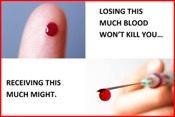Nurse Jennifer had a hepatitis titer drawn with HBV surface antigen, HBsAG, and anti-HCV antibodies. She was also drawn for an ELISA rapid blood test for HIV. She was asked to bring the needle as a specimen but had already thrown it away in the sharps container. She had to complete a full history of previous exposures including sexual relations, which may have impacted her risk.
The infection control nurse correctly cleansed the wound on her finger and then gave information for a potential Recombivax hepatitis vaccine and hepatitis immune globulin, if appropriate pending the lab results. The patient had known HIV-positive status but was asked permission to draw for HBV and HCV. The patient agreed, and now both the patient and Jennifer had to wait 1 hour for the HIV results. Jennifer would also now have to be tested at 6 and 12 weeks, and 6 months after exposure.
She would be started immediately on PEP, and plan to continue with the multi-pill regimen for 4 weeks. The PEP would include Truvada (tenofovir/emtricitabine, 300/200 mg daily) plus Isentress (raltegravir, 400 mg twice daily). Alternative regimens are also available.

Source: Google Images.
Work practice controls are intended to reduce the likelihood of exposure by changing the way a task is performed. They include appropriate procedures for handwashing, sharps disposal, lab specimen handling, laundry handling, and contaminated material cleaning (OSHA, 2019b). Work practice controls are commonly described in written procedures in the workplace.
Universal vs. Standard Precautions
The OSHA Bloodborne Pathogens Standard specifies “Universal Precautions shall be observed to prevent contact with blood or other potentially infectious materials.” When you can’t tell the difference, “all body fluids should be considered potentially infectious.”
Comparison of Universal and Standard Precautions | ||
|---|---|---|
| Universal precautions | Standard precautions |
First proposed year | 1992 | 1996 |
Proposed by | Federal OSHA | CDC |
Authority is based on | Federal law | Science |
Protects | Workers only (not patients) | Workers and patients |
Use precautions with | All patients | All patients |
Protects from | Bloodborne pathogens only | Viruses, bacteria and protozoa |
Stay out of | Blood and listed OPIM (see module 3) | All body fluids, mucous membranes and non-intact skin |
Broadness of requirements | Limited to OSHA requirements | Broader than Universal Precautions |
Is it preferred to use Standard Precautions? Standard Precautions includes all the requirements of Universal Precautions and more. When you use Standard Precautions, you are in full compliance with OSHA’s requirement to use Universal Precautions.
The key provision of both types of precautions is that workers must avoid contact with blood and body fluids of all patients, regardless of diagnosis, because most people who do carry a bloodborne pathogen have no symptoms and often do not know they are a carrier. Avoid contact with blood and body fluids of all patients to protect yourself, your other patients, your co-workers, and your family.
Other Work Practice Controls
The Bloodborne Pathogens Standard specifies other work practice controls:
- Eating, drinking smoking, applying cosmetics or lip balm, and handling contact lenses are prohibited in work areas where there is reasonable likelihood of occupational exposure to body fluids. Some work places post signs where body fluids, used gloves, and specimens are not allowed, and permit eating and/or drinking in those areas.
- Procedures involving blood or OPIM shall be performed in a manner to minimize splashing or generation of droplets. Mouth pipetting is specifically prohibited.
Test Your Knowledge
When you use Standard Precautions you are in full compliance with OSHA’s requirement to use Universal Precautions.
- True
- False
Standard Precautions:
- Do not cover all the requirements of the Bloodborne Pathogens Standard.
- Consider all body fluids of all patients to be potentially infectious.
- Require wearing of gloves for dry skin contact with all patients.
- Are not feasible in settings such as correctional institutions.
Apply Your Knowledge
Explain the difference between standard and universal precautions. How does your physical uniform, hair, nails, and equipment contribute or decrease your risk of pathogen contamination?
Answers: A,B
